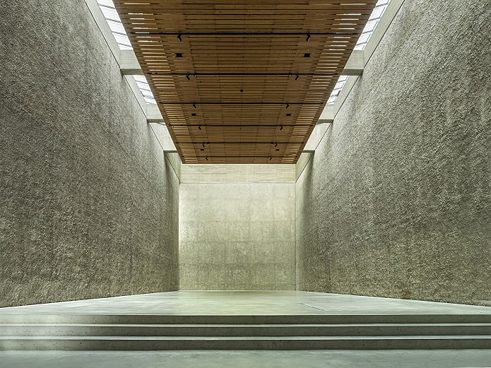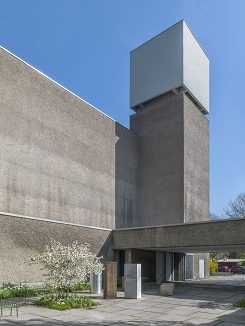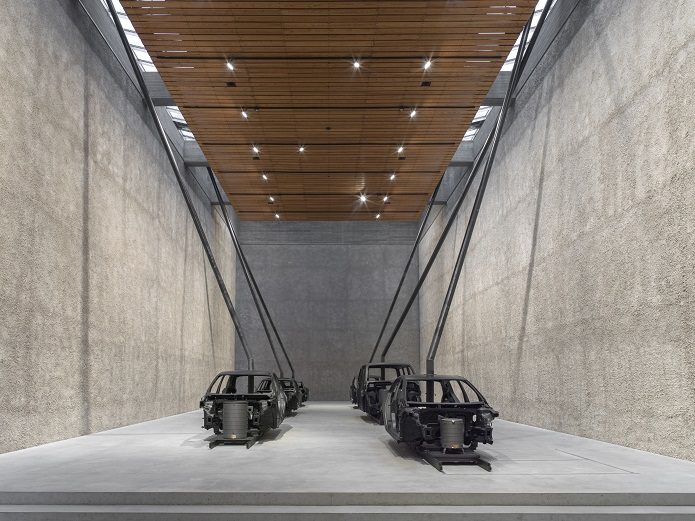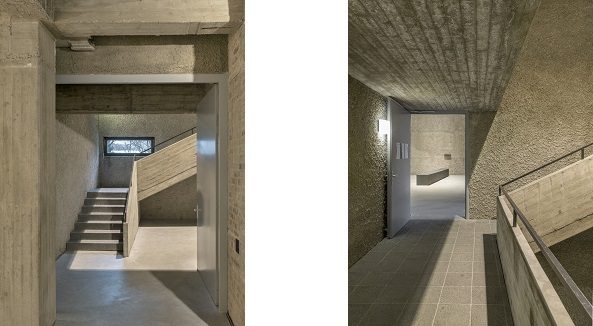Bicultural Urbanite Luke
Brutalist Heaven: Inside Berlin’s Most Ethereal Gallery Space

Berlin is undoubtedly a city that thrives on its adventurous use of space. Relaxed premises licensing and planning permission regulations result in a whole range of unusual occurrences: acclaimed art exhibitions housed in Nazi war bunkers; debaucherous techno parties running rampant in old swimming pools, power plants, and virtually any other kind of vacated building you can imagine; burger joints serving patties out of what used to be public toilets under the overground train line—right in the middle of a chaotic intersection.
This kind of rogue, flamboyant approach to the spatial dissemination of culture, business, and pleasure was one of the first things to spark my infatuation with Berlin when I arrived here as a wide-eyed tourist. Every outing was enchanting. When you come from a city as bubbled-wrapped and stiffly regulated as Melbourne—where even the wearing of helmets when riding a bicycle is policed with frightening vigilance and the rare attempt at throwing a warehouse party is shut down by the cops in a matter of hours—acquainting Berlin’s bold mode of event planning and property development feels wonderfully naughty.
 St. Agnes outside view, courtesy of König Galerie
| © Roman März
One of my favourite examples of a Berlin building being re-appropriated in a manner deviant to its original purpose is the current location of König Galerie. Founded by Johann König in 2002, the esteemed gallery with a penchant for cross-medial, spatial-based art enjoyed multiple addresses around the city before settling at its most striking Berlin site yet in 2015—a former church and community centre, ST. AGNES. Situated in the geographical centre of the city, the Brutalist complex has been cleverly re-utilised by Johann and Lena König with the assistance of architect Arno Brandlhuber—and to remarkable effect.
St. Agnes outside view, courtesy of König Galerie
| © Roman März
One of my favourite examples of a Berlin building being re-appropriated in a manner deviant to its original purpose is the current location of König Galerie. Founded by Johann König in 2002, the esteemed gallery with a penchant for cross-medial, spatial-based art enjoyed multiple addresses around the city before settling at its most striking Berlin site yet in 2015—a former church and community centre, ST. AGNES. Situated in the geographical centre of the city, the Brutalist complex has been cleverly re-utilised by Johann and Lena König with the assistance of architect Arno Brandlhuber—and to remarkable effect.
GOD IS IN THE DETAILS
Perhaps the most salient aspect of the property’s rebirth as a space to showcase the work of emerging and established artists is simply the essential retainment of its original condition. God really is in the details—or in this case, the deliberate lack thereof. In homage to its inceptive Brutalist design, Brandlhuber restrained his re-design of the 5,090 square metre area to “simple forms and materials while refraining from ornaments and letting the materials be in their natural colours”, as the gallery puts it. As a result, the pared-down ethereal beauty of the upstairs exhibition area remains achingly pure enough to be initially more arresting than the art it holds.Far from detracting from the exhibitors’ work, however, this seems to provide a kind of limbic entry point of perception for patrons—a visceral-emotional prepping—before the more cerebral activity of acquiring and dissecting cultural capital unfolds. In other words, you feel the impact of the space and its artistic contents before you start to consider what they might mean. If an artist is intuitive enough, they may harness this force as prescriptive in the design of their creation for the gallery space, as did German artist Michael Sailstorfer with his gargantuan installation of last year.
 Michael Sailstorfer, Installation ‚Hitzefrei‘, König Galerie, 2017
| © Roman März
A formidable work comprised of several internal frameworks of production automobiles, Sailstorfer’s ‘Brenner’ of his 2017 ‘Hitzefrei’ exhibition included a number of metallic cylindrical elements reaching all the way to the impressive heights of the old chapel’s ceilings, allowing the skylights to illuminate the imposing structures from above and cast long, spidery shadows across the expansive bare walls. The impression was that the space had been designed specifically to accommodate its contents rather than vice-versa; elevating the level of spatial-conceptual cohesion and thereby intensifying the work’s impact.
Michael Sailstorfer, Installation ‚Hitzefrei‘, König Galerie, 2017
| © Roman März
A formidable work comprised of several internal frameworks of production automobiles, Sailstorfer’s ‘Brenner’ of his 2017 ‘Hitzefrei’ exhibition included a number of metallic cylindrical elements reaching all the way to the impressive heights of the old chapel’s ceilings, allowing the skylights to illuminate the imposing structures from above and cast long, spidery shadows across the expansive bare walls. The impression was that the space had been designed specifically to accommodate its contents rather than vice-versa; elevating the level of spatial-conceptual cohesion and thereby intensifying the work’s impact.Besides appreciating ambitious creations like ‘Brenner’, part of the ST. AGNES experience is the same as that of many other Berlin architectural conversions: absorbing the omnipresence of the history attached to the location in combination with its new function. After the bombings in 1945, the surrounding residential area of the original catholic parish was annihilated; the community’s church was destroyed and Werner Düttmann, an architect and city planner renowned for helping shape Berlin’s skyline undertook the redevelopment task. The coalescence of this kind of past with something like Sailstorfer’s artistic commentary on modern consumption culture within the one space incites a particular kind of layered poignancy—one that is a hallmark of the Berlin experience.
 St. Agnes staircase, courtesy of König Galerie
| © Roman März
St. Agnes staircase, courtesy of König Galerie
| © Roman März